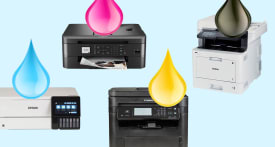Your Guide to Hearing Helpers
The differences among hearing devices can be subtle. Here's what to know about the categories.

Thanks to new rules the FDA put in place last fall, hearing aids are now divided into two key categories: prescription and over-the-counter. OTCs can be further divided into two types: self-fitting and preset.
You may also come across devices known as personal sound amplification products (PSAPs) and "hearables" in retail stores and online. These aren’t considered hearing aids but could be helpful in some instances.
Check this chart for the lowdown on each of these kinds of hearing devices.
OTC Hearing Aid Options
Self-Fitting
Where to buy them: In a retail setting such as a drugstore or electronics store, or online.
Pros: Currently, self-fitting hearing aids must be cleared as both safe and effective by the Food and Drug Administration. Because they’re far more customizable than preset OTC hearing aids, they may suit your specific hearing needs better. Self-fitting aids can be significantly less expensive than prescription hearing aids. (They start at about $699 per device.)
Cons: While you’ll probably be guided by an app to set up your aids, the self-fitting process might be challenging for some people, particularly those who are less technologically inclined.
Other Options
Prescription Hearing Aids
Pros: Those professionals vet hearing aids and can help ensure quality and that the aids work properly for you. As part of the purchasing process, you’ll also receive a professional hearing test and help selecting a hearing aid. And the hearing care provider will program your device so that it treats your specific hearing problems. Follow-up adjustments are often included.
Cons: Price. A pair can cost about $1,000 to $6,000 and is usually not covered (or not fully covered) by insurance. In addition, you’ll have to go to the provider’s office or a retail location for in-person appointments.
Personal Sound Amplification Products (PSAPs) and Other ‘Hearables’
Where to buy them: In a retail setting such as a drugstore or electronics store, or online.
Pros: Price (PSAPs can be found for less than $20). Other devices broadly known as “hearables” tend to have many functions, including some hearing-aid-like features. For instance, with Apple’s AirPods Pro earbuds, you can listen to music, reduce unwanted background noise, and amplify sounds you want to hear (like a lecture).
Cons: PSAPs, which are meant to be used by people without hearing loss in order to amplify sound in situations like bird-watching, aren’t hearing aids (and aren’t subject to FDA rules about hearing aid safety and quality). Hearables aren’t allowed to be marketed for hearing loss.
Editor’s Note: This article also appeared in the May/June 2023 issue of Consumer Reports magazine.

















